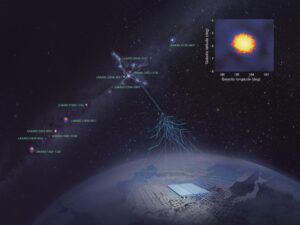
Measuring PeVatrons with LHAASO

View from satellite of the LHAASO experiment. Clearly visible, in the center, the complex of Water Cherenkov Detector Array surrounded by the Muon detectors. Credits: LHAASO
In the recent paper appearing in Nature, the LHAASO observatory reported on its observation of 12 gamma-ray sources and its measurement of a gamma ray with an energy of 1.4 PeV, the highest ever detected.
The LHAASO Observatory has been conceived as a dual task facility for cosmic-ray (CR) studies at energies above the TeV up to several EeV and γ-rays up to few PeV.
The installation – sitting at 4,410 m above sea level near the Daocheng Airport, on the Haizi Mountain in the Sichuan Province of China – features four different types of detectors to cover a wide energy range and allow to measure not only the shower direction, energy, and profile but also its muon and electron content.
The Water Cherenkov Detector Array (WCDA), 3 pools covering a total area of 78’000 m2, is in the middle of the Kilometer Square Array (KM2A), which covers an area of 1.3 km in diameter, instrumented with about 1200 muon detectors and 5200 electromagnetic detectors. A Wide Field-of-view Cherenkov Telescope Array (WFCTA) complement the installation, with its 18 Telescopes capable of working in Cherenkov and Fluorescent mode.
The array will be completed by the end of July 2021, but science operation started since the end of 2019 with half of the array.
Combining the four different types of detectors, LHAASO will be able to measure air showers generated by cosmic rays or gamma rays with multiple variables simultaneously. Basic information about the incident particles, such as arrival direction, type, and energy, can be measured through the reconstruction of the showers.
Using this approach, LHAASO gave a glimpse at possible sources of gamma rays, which could solve once forever the riddle on the origin of the cosmic rays.
Tracing the origin of these high-energy cosmic rays is not straightforward; they must travel across the Universe through magnetic fields present in space that curl their trajectories.
Therefore, when we detect such a cosmic ray arriving at the earth, we may be able to determine the direction it arrived from, but this is not necessarily the same direction it started from.
Luckily cosmic rays should produce γ-rays close to their accelerators, so searching instead for the sources of high-energy γ-rays, which are not affected by the magnetic fields, we can pinpoint their origin.

Artistic view of LHAASO and the position of the twelve detected sources in the Milky Way. Credits: LHAASO
The results presented in the recent Nature publication claim for the first discovery of both electrons and proton PeVatrons.
PeVatrons is the name given – in analogy with particle accelerator as synchrotron, cyclotron, etc. – to the powerful cosmic accelerators responsible for these extremely energetic cosmic rays.
These Cosmic Ray ‘Factories’, perfectly designed by Nature, are incredibly efficient machines accelerating particles at a rate close to the absolute theoretical margin determined by the classical electrodynamics and magnetohydrodynamics.
Even if it remains an open question what they are, these new results provide some important clues.
One source of the published list is the famous Crab Nebula, which evolved from the “guest star” recorded by the imperial astronomers of China’s Song Dynasty to become, nowadays, the standard candle in high-energy astronomy used for calibrating new UHE gamma-ray source.
In the Science paper published in July, LHAASO has reported the results of the accurate measurement of the Crab Nebula emissions over 3.5 orders of magnitude, recording an event with an energy of 1.1 PeV, identified as a photon even if it cannot be excluded to be a proton.
The measurement of such a photon indicates the presence of an extremely powerful electron accelerator—about one-tenth the size of the solar system—located in the core region of the Crab Nebula.
For the first time, it was possible to verify that gamma-ray spectra extend beyond 1 PeV, proving the PeVatrons do exist in the Milky Way, and these findings bring us closer to understanding the origins of extremely high energy cosmic rays.
With an expectation of detecting 1-2 photons with energies around 1 PeV from the Crab Nebula every year, the puzzle of the cosmic PeV electron accelerator will be unraveled in the coming years.
As a matter of fact, the measured 1.1 PeV photon provides direct evidence for the acceleration of 2.3 PeV electrons in the source. Since high energy electrons suffer strong energy loss in a magnetic field, the accelerator in the Crab Nebula must operate at an incredibly high efficiency to balance the huge energy loss. According to the LHAASO measurement, its acceleration efficiency can reach 15% of the theoretical upper limit, thus surpassing that of the supernova blast wave by a factor of 1,000. This poses challenges to the standard paradigm of electron acceleration in high-energy astrophysics. An in-depth analysis and discussion of this topic are detailed in the paper in Science.
The results reported in the Nature and Science articles can be considered as the tip of the iceberg, being achieved with a partial array. In the coming years, we expect many breakthrough discoveries by LHAASO that could dramatically change the current understanding of the most energetic and extreme phenomena of the non-thermal Universe.
The LHAASO collaboration
Further information:
- LHAASO website: http://english.ihep.cas.cn/lhaaso/
- Ultrahigh-energy photons up to 1.4 petaelectronvolts from 12 γ-ray Galactic sources
Cao, Z., Aharonian, F.A., An, Q. et al. for the LHAASO Collaboration, Nature 594, 33–36 (2021), https://doi.org/10.1038/s41586-021-03498-z - PeV gamma-ray emission from the Crab Nebula
Cao, Z., Aharonian, F.A., An, Q. et al. for the LHAASO Collaboration, Science 08 Jul 2021: eabg5137, https://doi.org/10.1126/science.abg5137




